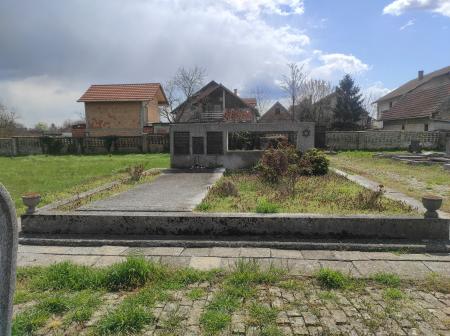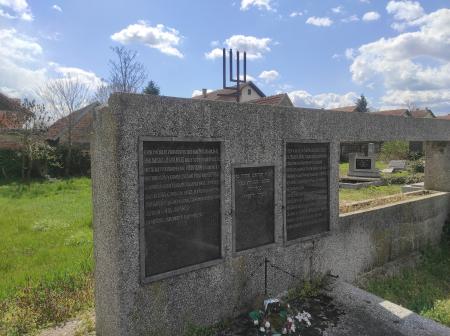Obj. ID: 39095
Jewish Funerary Art Holocaust memorial in the Jewish cemetery in Sombor, Serbia, 1964
To the main object: Jewish cemetery in Sombor, Serbia

Memorial Name
No official name
Who is Comemmorated?
The 700 Jewish forced laborers from the Bor Mine Forced Labor Camp who were murdered in 1944 in Crvenka
Description
The monument consists of an upright slab on an elongated one-stepped rectangular platform. The platform is partially covered - the covered section creates a path to the slab on which the memorial plaques are mounted. The upright slab is rectangular, made of greyish stone, and bears three plaques of black marble with commemorative inscriptions in Serbo-Croatian, Hebrew, and Hungarian. On the top, it features a menorah and Magen David made of iron designed in a minimalist, geometric mode.
The text of the Serbo-Croatian and Hungarian inscriptions are identical; they both say that 700 Jews from Hungary and Yugoslavia, forced laborers at the Bor mine, who the fascists murdered in October 1944, are buried beneath this monument. The Hebrew inscription is distinct and demands justice for the martyrs' unjust death.
Inscriptions
Serbo-Croatian
Ovde počivaju posmrtni ostaci oko 700 Jevreja iz
Mađarske i Jugoslavije koje su zločinački fašisti
mučili na prinudnom radu u Borskom rudniku a u
oktobru 1944. godine zverski ubili kod Crvenke.
Njihovi su ostaci sahranjeni ispod ovog spomenika
koji je 1964. g. podigao Savez jevrejskih opština
Jugoslavije u saradnji sa Zemaljskim predstavništvom
Jevreja u Mađarskoj.
Za večitu uspomenu i opomenu
Translation: The remains of around 700 Jews from Hungary and Yugoslavia, who the criminal fascists tortured in forced labor in the Bor mine and brutally killed near Crvenka in October 1944. Their remains are buried under this monument which was in 1964 erected by the Federation of Jewish Communities of Yugoslavia in cooperation with the National Presidency of Hungarian Jews. For eternal memory and reminder.
Hungarian
Ezen a helyen 700 magyarországi
és jugoszláviai zsidó kényszermunkás
földi maradványai nyugszanak.
Fasiszta gonosztevők kinozták őket
Borban, majd 1944 októberében Crvenka
mellett valamennyit állati módon
meggyilkolták.
Ezt az emlékművet, amely csontjaikat
őrzi ,1964-ben a Magyar Izraeliták
Országos Képviseletének hozzájáru-
lásával a Jugoszláviai Zsidó közös-
ségek Szövetsége emeltette.
Örök emlékül és figyelmeztetésül.
Translation: The remains of 700 Jewish forced laborers from Hungary and Yugoslavia rest in this place. Fascist criminals tortured them in Bor, and in October 1944, near Crvenka, They were all murdered in a barbaric manner. This monument, which preserves their bones, was erected in 1964 by the Federation of Jewish Communities of Yugoslavia with the contribution of the National Presidency of Hungarian Israelites. As an eternal reminder and warning.
Hebrew
לזכרון הקדושים שנהרגו כאן בשובם מעבודת כפיה מבור הי'ד לתורה ולתעודה
Translation: In memory of the martyrs who were killed here on the return from forced labor in Bor, let God revenge their blood according to law and testimony
Commissioned by
The Federations of Jewish Communities of Yugoslavia and Hungary
With the assistance of the Yugoslav Federal Secretariat for Health and Social Policy and the National Presidency of Hungarian Jews.
sub-set tree:
Black Marble
Iron
Provide a brief history of the creation of the monument and its subsequent use and reception.
The memorial to the Bor mine victims also serves as a mass grave containing the exhumed remains of 700 Jewish forced laborers killed in Crvenka. A total of 6,000 Jews from Hungary were conscripted as forced laborers at the Bor mine camp, including roughly 600 Jews from Bačka. The Jewish prisoners were taken on death marches in September 1944. In a brickyard in Crvenka, near Sombor, over 1,200 of them were shot dead. At the first postwar conference of the Jewish communities in Yugoslavia, held in 1947, a demand for an urgent exhumation and appropriate burial of the murdered was made. The report stated that the bodies started resurfacing from the shallow mass grave in which they had been buried. Even though finding a lasting solution to this matter was given top priority, the full exhumation wasn't completed until 1957, when the bodies were transferred to the Jewish cemetery in Sombor where they were buried. The creation of the monument took an additional 7 years.
Over a thousand people attended the unveiling ceremony on April 19, 1964, on the anniversary of the Warsaw Ghetto Uprising. Speakers included members of the National Presidency of Hungarian Jews, the Hungarian Committee of the Persecuted during Nazism, the Federation of Jewish Communities of Yugoslavia, and the Union of Fighters of the National Liberation War. The following quote from one of the speakers, who stated that "this monument is one of the symbols of the spilled blood of the Hungarian and Yugoslav peoples in their struggle against fascism," captures the overall tone of the ceremony, despite the participation of Jewish representatives and even two rabbis. The victims were considered to be Yugoslav and Hungarian citizens, and the act of remembering them did not take their Jewish origin into account. In addition, the date chosen for the unveiling presents the victims as active subjects and puts them in the context of Jewish resistance. It is interesting to note the different nature of the commemorative inscriptions. The inscriptions in Serbo-Croatian and Hungarian have identical content - commemorating the victims of fascism and providing details about their later exhumation and burial, while the text in Hebrew delivers a very different message, seeking justice for the unjust death of the martyrs.
Members of the Jewish community of Sombor mark annually the International Holocaust Remembrance Day (January 27) at this memorial. On this day, they commemorate and remember the Yugoslavian and Hungarian Jews, prisoners of the Bor camp executed in Crvenka in 1944, whose remains found their final resting places in the Jewish cemetery in Sombor. In 2003, Holocaust Remembrance Day (Yom Hashoah) was commemorated on April 18.
Beljanski, Milenko, “Somborski Jevreji.” (Zbornik 4: Studije, arhivska i memoarska građa o Jevrejima Jugoslavije, Jevrejski istorijski muzej - Beograd, 1979), pp. 1-56.
"Memorials in Sombor," Locations (Vojvodina Holocaust Memorials Project), https://www.vhmproject.org/en-US/Locations/Memorials/20 ( (accessed June 21, 2023)
Prodanović, Dragoljub, “Jevrejsko groblje u Šikari kod Sombora i ponešto o sudbinama živih.” Zbornik 8: Studije, arhivska i memoarska građa, Jevrejski istorijski muzej (2003), pp. 371-400.
Stipić, Davor. 'U borbi protiv zaborava: Jevrejska zajednica u Jugoslaviji i očuvanje sećanja na Holokaust 1945–1955.” Godišnjak za društvenu istoriju 2 (2016): 91–121, pp. 91-121.













